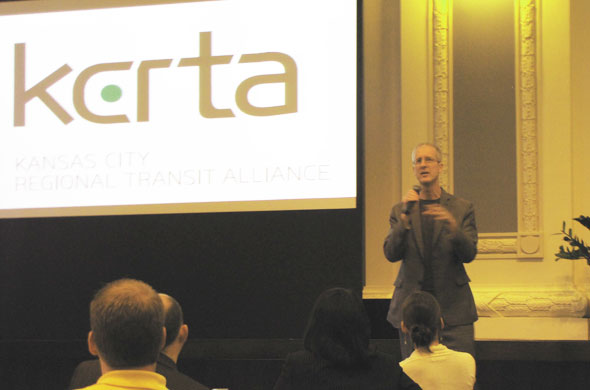
Jeff Speck, a city planner and architect who wrote “Walkable City, how downtown can save America one step at a time,” addressed transit advocates yesterday.
By Joe Lambe
“The pedestrian is an extremely fragile species, the canary in the coal mine of urban livability. Under the right conditions this creature thrives and multiplies” – from Walkable City by Jeff Speck
The Kansas City Regional Transit Alliance had much to celebrate at a luncheon Tuesday and dessert was a taste of the change coming to cities.
“Before this year ends we’re going to have streetcars under construction – I say amen,” Kite Singleton, outgoing chairman, said at Union Station.
The city that once was a national leader in miles of streetcar routes is to have a 2-mile downtown starter line as early as 2015.
New efforts are also under way toward the group’s goal of borderless transit, he said, with buses running from Johnson and Wyandotte counties into Kansas City.
Other planned projects include lobbying Missouri legislators for money for area transit and trails.
The speaker was Jeff Speck, a city planner and architect who wrote “Walkable City, how downtown can save America one step at a time.”
Transit works with walking and biking to transform and save cities, he said.
He said city planners and traffic engineers made 50 years of mistakes promoting cars and suburbs – a pattern that is changing.
The millennials, born from early 1980s to early 2000s, are flocking to cities they like, and they like walking, biking and transit.
Most were raised in suburbs and want out, Speck said. One-in-four teens now does not get a driver’s license, compared to one-in-10 about 40 years ago, he said. “They’re probably just sick of being chauffeured around their whole lives.”
And many of their parents, after getting them out of the house, are also moving to cities where they do not have to drive, he said.
Many parents left cities for better schools long ago – the main reason for leaving cities – and that is no longer an issue with adult children, he said.
So they move to norcs, “naturally occurring retirement communities,” where they can walk to coffee shops and stores.
Portland, Ore., blazed the way forward in the 1970s when it invested in transit and biking while other cities carved out more roads, he said.
“They went to biking 15 times more than anyone else,” he said, and 43 percent of their children bike or walk to school compared to 3 percent nationwide.
“Young educated people have been moving to Portland in droves,” he said. “That’s the way to compete, … not to steal a corporation from another state but to be a place where people want to be.”
Sociologists, health experts and even environmentalists are also backing cities and walking, turning against suburbs and cars, he said.
The suburban lack of exercise causes obesity and related diseases and the cars kill, he said.
Compute the murder rates and the car death rates, Speck said, and “You’re safer in the grittiest inner city than you are in the country club suburbs.”
City Councilman Russ Johnson, a leader of the streetcar effort, asked Speck why transportation policy is driven by people who sell things like asphalt – where are the people selling walkable solutions?
There are not as many of them and they don’t have that much money, Speck said, “so grassroots are essential.”
Change is coming, he said, and Kansas City has made progress in spite of having more traffic lane miles than any city in the nation.
In closing, he quoted Winston Churchill: “Americans can be counted on to do the right thing after they have exhausted their alternatives.”



Who’s talking